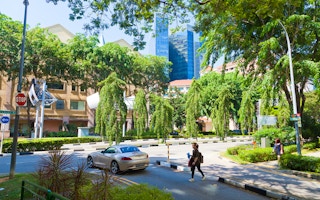Singapore, South Korea and Hong Kong are among the world’s 10 most environmentally and economically sustainable cities. The cities came in 10th, 7th and 8th respectively, according to the inaugural Sustainable Cities Index released on Monday, 9th February, by Dutch design and consultancy firm Arcadis.
To continue reading, subscribe to Eco‑Business.
There's something for everyone. We offer a range of subscription plans.
- Access our stories and receive our Insights Weekly newsletter with the free EB Member plan.
- Unlock unlimited access to our content and archive with EB Circle.
- Publish your content with EB Premium.
Europe clinched the other top spots in the study, conducted by the UK-based think tank Centre for Economics and Business Research, which assessed 50 cities on how well they do in the three key areas - people, planet, and profit - widely considered essential to sustainable development.
Germany’s Frankfurt was the top-performing city on the index, with UK’s London in second place and Denmark’s Copenhagen in third position. The Dutch cities of Amsterdam and Rotterdam, Germany’s Berlin and the Spanish capital Madrid are also among the top 10.
Eugene Seah, city executive director for Singapore, Arcadis, explained that the triple bottom line approach, which examines a range of social, economic, and environmental issues, “is one of the best approaches for a city to understand where it really stands”.
“Such indices can help city leaders celebrate the areas they excel in and learn from others where they are lagging behind,” he added.
Singapore did especially well on the ‘Planet’ and ‘Profit’ sub-indices. The Planet index looks at a city’s energy consumption, recycling rates, air pollution, drinking water and sanitation, among others, while a city’s ease of doing business, importance in global economic networks, property and living costs feed into the ‘Profit’ index.
As the only Asian city in the top 10 of the Planet sub-index, Singapore was recognised for its efforts to keep sustainability at the core of urban master-planning; for example, through the national Building and Construction Authority’s aim to make 80 percent of all buildings certified sustainable by 2030.
The city-state also came in eighth on the ‘Profit’ index, behind Hong Kong (3) and Seoul (7), a testament to its status as a global financial hub and preferred headquarters among multinationals.
However, the report noted that “inefficient use of energy, which drives up the cost of doing business, holds back Singapore from an even higher score”.
This strong performance, “is thanks to the thought leadership and robust urban planning strategies by our political leaders,” said Seah.
These include a heavy emphasis on transport infrastructure as the city-state develops, and building a strong healthcare system to care for an ageing population, he added.
“
As cities undergo rapid urbanization, they cannot lose sight of the social and environmental aspects of development. There must be very strong policies to achieve a balanced approach and pursue these goals in parallel.
Eugene Seah, city executive director for Singapore, Arcadis
Asia in general performed poorly on social factors, the report found, citing that Asians worked on average 20 percent longer hours than the global average.
But grappling with the ‘People’ aspect was a common struggle for all cities on the index, noted the report. Cities tended to perform better on Profit and Planet indicators, but were generally becoming less affordable for their citizens and working hours for them are longer.
Professor Heng Chye Kiang, Dean of the National University of Singapore’s School of Design and Environment, noted that Singapore has done well on the index, considering its unique challenges as a small city-state with a large and densely packed population.
“Despite not having the luxury of large wind or solar farms, or hydroelectric or geothermal projects, we have done well on the ‘Planet’ index,” he said, comparing Singapore with other cities on the top of the index like Frankfurt and Copenhagen, which had population sizes of 700,000 and fewer than 600,000, respectively.
Asian cities also brought up the rear of the index, with the bottom five spots occupied by Jakarta, Indonesia; Manila, Philippines; Mumbai, India; Wuhan, China; and New Delhi, India.
Seah was optimistic that rapid technology transfers and knowledge sharing with cities higher on the index will help these cities improve their performance.
Governments in the region are also trading and investing heavily in infrastructure and trading, noted Seah, adding that the areas for improvement also presented valuable opportunities for businesses.
In Jakarta, for example, “there is great opportunity in the area of water – not just in terms of water supply and treatment, but in flood mitigation and coastal protection,” he explained, adding that Arcadis was also exploring how to address these urban challenges.
While it has yet to be decided if the index will be an annual or biannual affair, Seah urged Singapore to not “rest on its laurels” and raise the bar for its performance on all indicators, and predicted that “Singapore will maintain its top 10 position on future indices, and its closest Asian competitor will be Hong Kong”.
“As cities undergo rapid urbanization, they cannot lose sight of the social and environmental aspects of development,” he said. “There must be very strong policies to achieve a balanced approach and pursue these goals in parallel.”
Edited by Jessica Cheam and Stanley Tang








